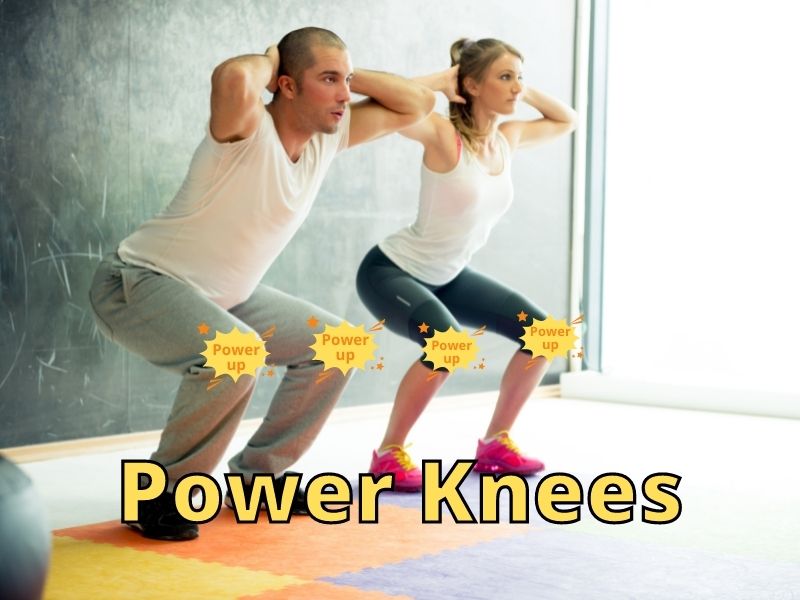(Consult a doctor before starting any exercise program)
If you want to strengthen your knees, there are many exercises that can help. The knees can get hurt during exercise, sports, or accidents. Having strong knees can help reduce healing time and prevent injuries from occurring.
To strengthen your knees you need to exercise the muscles around your knees (Hamstrings, quadriceps, calves). The following exercises can help.
- Leg Press – Quadricep, glute, and hamstring muscles get stronger
- Hamstring Curl – Hamstring muscles get stronger
- Stairs/Step Platform – Quadricep, hamstring, and calf muscles get stronger
- Freestyle Swimming – Quadricep, hamstring, glute, and some calf muscles get stronger
- Leg Extension – Quadricep muscles get stronger
- Calf Raises – Calf muscles get stronger
- Toe Taps – Shin muscles get stronger
- Straight Leg Raises – Quadricep and hip muscles get stronger
- Side Leg Raises – Quadricep, glute, and hip muscles get stronger
- Prone Leg Raises – back, glutes, and hamstring muscles get stronger
- Squats – Quadricep, hamstring, glute, and calf muscles get stronger
- Wall Squats – Quadricep, glute, and calf muscles get stronger
These are just some of the exercises you can do. Many of your leg and lower body muscles are used to a greater or lesser extent during these exercises.
If you have a knee injury, you should avoid exercises unless directed by your doctor. When your ready, try these exercises without weights first. You can lay down, sit, and stand next to a chair for support to do many of these exercises and variations.
Exercises to Strengthen Your Knees
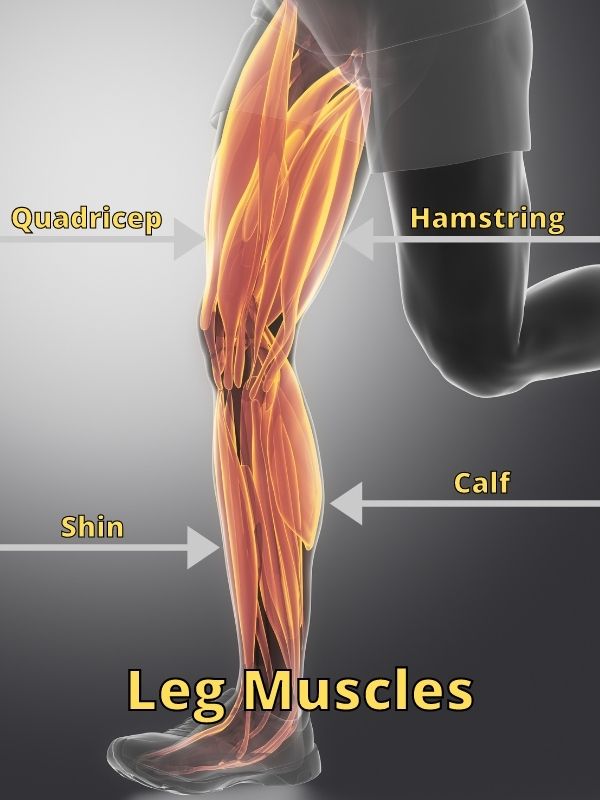
If you haven’t exercised for a while or have a knee injury or pain, you may want to increase your knee strength and stability.
When we exercise, play sports, and do other activities that place high levels of pressure on our knees, we increase the likelihood of knee injury. This doesn’t happen as much for those who have strong knees.
The muscles in your leg can relieve some of the forces that occur during various activities. Strong muscles will help you increase your ability to recover from injury and have less pain.
If you strengthen all the muscles around your knees, your legs will better be able to handle the pressures that they are under, ranging from walking to weight lifting.
It’s best to take it slow when first starting your exercise routine to build up your muscle; doubly so when you have knee injury or pain.
If you watch this video below with Doctor Jo, she explains some ways to exercise and strengthen your knees in a safe manner, especially helpful for those with weak muscles or recovering from injury.
If you take a slow and steady approach to strengthen your knees, you will be more likely to gain strength over time without further injury and with less pain.
The following exercises discussed below can all be modified to meet your needs. You can start with weights from day one, or put little pressure on your joints.
A good place to start is to do 10 repetitions of an exercise without weights and see how your body reacts. You can judge by seeing how out of breath you are, how much effort was exerted, and if there is any pain.
Then you can level up or down the amount of weight you use each week. It’s important to take monitor yourself and not try to push too much too fast. I’ve hurt myself a couple of times trying to do too much too soon.
Below are some example videos of knee strengthening exercises. You should modify these exercises to help you get knee strengthening benefits with whatever level you’re at.
1. Leg Press to Strengthen Your Knees
Leg Press by Help ShoeIf you go to the gym you may have used the leg press. This is a good machine to use to help with a controlled push with your legs. You may feel your quadriceps working quite a bit after you’ve finished a couple of sets.
You will have worked your glutes and hamstring muscles also. Using a machine with weights can help you avoid injury if you are using it correctly with the right amount of weight.
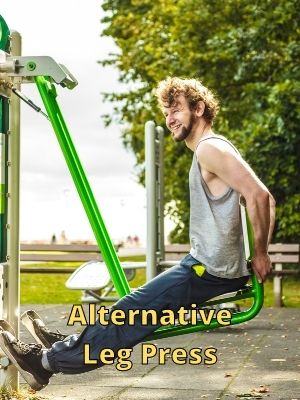
You may need to modify your leg press to use less or no weight. Sitting in a swing or hammock against a solid surface can help you do a leg press style exercise.
Try to avoid anything deeper than a 90-degree angle in your knees. Strain may occur on your joints by bending them too far.
Try to keep your back straight and try not to overextend your legs as you push.
Avoid using the leg press if you feel too much strain on your lower back or knees. Other similar exercises, if done properly, can allow for more natural movement.
2. Hamstring Curl to Strengthen Your Knees
Hamstring Curl by Help ShoeYou can use a machine or stand up without weights and perform a hamstring curl. You want to fully extend your legs and bring your foot up behind your knee to a 90-degree angle.
This exercise is good for your hamstring muscles to get stronger. There are various machines that can help you do a hamstring curl.
Make sure to adjust the machine to fit the length of your leg. Try to start off with a lightweight and add more until there’s some effort needed to move the weight.
If should feel fairly comfortable and your movements should be smooth and not jerky. Too much weight can result in bad form and cause muscle strain.

An alternative way to perform a hamstring curl is to get down on your hands and knees and extend one leg straight back.
Then you curl your lower leg back without moving your upper leg.
Last, you extend your leg out again. Do a set of 10 and then switch legs and you will be working a lot more muscles than your hamstrings.
An easier way to do this and just focus on your hamstrings is to stand next to a chair for balance and curl your lower leg behind you at a 90-degree angle.
Then you extend your leg again and repeat.
3. Stairs/Step Platform to Strengthen Your Knees
Step Platform by Help ShoeA step platform can be a good way to start putting more pressure on a weak knee. Many platforms allow you to start with a low step and then you can add more height.
They are versatile and you can perform a wide range of exercise routines with them. Stepping up on a platform helps work your quadricep, hamstring, and calf muscles.
All you need to do is step up with one foot and then the other. Then, step back down with one foot and then the other.
If you’re a bit unsteady, using a wall to brace yourself or something stationary to hold while stepping up and down will help.
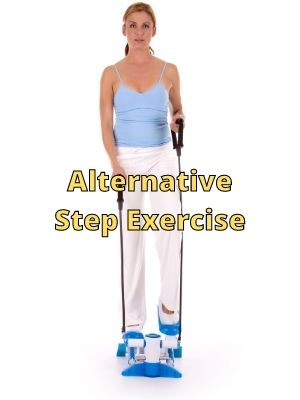
An alternative way to use steps is to climb some stairs or use a stepper to work your muscles.
A stepper can range from a lite workout to a more intense workout, depending on the setting that you use and the intensity you use.
These are good for use with a standing desk or when your watching TV. When you’re done, you can move it out of the way easily.
For those who just don’t have time, these offer a good way to multitask. Here’s a link to Amazon.com to find out more.
4. Freestyle Swimming to Strengthen Your Knees
Freestyle Swimming by Help ShoeI love to go swimming. It can be relaxing for me, as well as an intense workout if I ramp up my intensity. When your swimming freestyle you are exercising your quadricep, hamstring, glute, and some calf muscles.
The best thing about swimming is that it is low impact, so your knee doesn’t have the pressure on it like most other exercises that strengthen your knee.
This means you can heal and strengthen your knee with a lower risk of reinjury if you had knee problems. I like that it is also a good exercise for cardio, so you’re getting a heart-healthy exercise at the same time,

Using a kickboard or swim board means you are not using your arms and are specifically targeting your legs.
This is a great way to place either more or less pressure on your legs. You can go slowly and work on controlled kicks to avoid re-injury if needed, or intensify the workout and give your leg muscle a focused session.
Just like any other exercise, using controlled and slower movements can help you avoid strain.
As you swim you can work more a wider range of leg muscles when specifically focusing on controlling your kicks.
5. Leg Extension to Strengthen Your Knees
Leg Extension by Help ShoeIf you go to the gym, you might have used a leg extension machine. These are helpful for strengthening the quadricep muscles.
Some people don’t like using it because they say it’s not naturally what the body normally would need to do. Under normal conditions, we don’t have to extend our legs with weight.
I still find value in leg extensions because it seems to me that the quadricep muscles can help relieve pressure on your knee joint. This can lower the impact that running and other exercises have on your knee.
In addition, having stronger and well-balanced muscles around the knee can help stabilize it and prevent injury in the future.

A natural way to strengthen your knee is to do leg extensions without weights. Just extend your leg straight out in front of you, at a 90-degree angle to your standing leg.
If you hold it for a few seconds you’ll really start to feel the quadriceps muscles working. Then you can switch legs.
This exercise may help you get more of your fine motor movement muscles involved, which may bring more stability to your knee.
Another extension of this exercise would be to extending your leg out straight and only drop your lower leg while keeping your upper leg stationary.
Then you would extend your foot straight out again.
6. Calf Raises to Strengthen Your Knees
Calf Raises by Help ShoeCalf raises are really good at working on a number of body parts. When you do them you are getting your calf muscles stronger.
These exercises can be helpful for your foot and ankle. You’ll gain more stability in your ankles and knees as your muscle get stronger. As your foot gets stronger, you will have better absorption of impacts, and foot strikes will impact your joints less.
Exercising without your shoes can be the most helpful in developing more muscles since you’ll likely be engaging more muscles as you control your balance as you do calf raises.
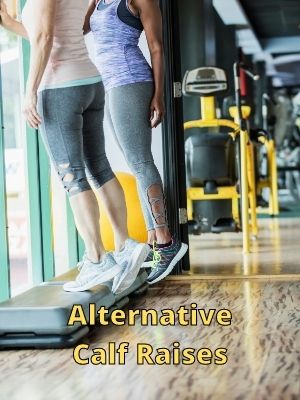
When you have a step platform you can hang one foot off and perform a one-leg calf raise.
This also enables you to get a wider range of motion with your ankle.
If you are standing next to a wall or have something to hold, it makes it easier to make a more controlled muscle movement. This can help you trigger more muscles for better muscle control.
You just need to go slow and not overdo it. And you won’t need to worry about balancing since the wall is there to hold.
7. Toe Taps to Strengthen Your Knees
Toe Taps by Help ShoeWhen you do toe taps you are increasing your shin muscles strength. Dancers often will do a similar exercise to help them treat and prevent shin splints.
As you lift up to your foot and gain muscle strength, you have better control of your legs. So your legs can take more of a beating like many dancers’ legs do.
So if you are sitting down in a chair or standing somewhere and waiting, you can try a set of ten toe taps for each foot, and see how it feels. Put
In this video, you can see that the Dr. uses an exercise band to push against. She explains that you can use this to help with shin splints.
The other exercise I think is easy for anyone to try is to walk on your toes (balls of your feet) and then walk on your heels with toes off the ground.
Watch the video for instructions and more shin strengthening exercises. As your shins get stronger, you’ll better be able to avoid injury and strengthen weak knees.
8. Straight Leg Raises to Strengthen Your Knees
While sitting on the floor with your leg straight out in front of you, lift one leg up while keeping it as straight as you can. This exercise will help strengthen your quadriceps muscles.
Similar to leg extensions, yet you are not bending your leg. You don’t need to raise your leg very high, but make an effort to keep your leg straight.
There may be increased pressure on your back, since maintaining good posture while raising your leg may be difficult. Place a roller (as seen in the picture) or a firm pillow behind your back for support.
Try to take pressure off your back by either straightening your back or adding additional back support so you can avoid back strain.
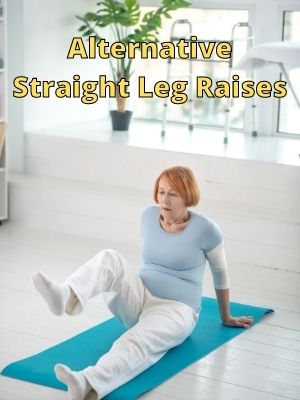
You can still strengthen your quadricep muscles by lifting your leg with your leg bent.
This is a good starting place for those with weaker muscles or those who have leg or back pain.
Try ten repetitions of raising your leg with your knee partially bent. You can see how difficult or easy it is and modify how many you do and the angle of the bent knee.
Remember that going slowly can help with increased muscle development and less risk of injury.
You want to have enough pressure but not too much, so you can achieve maximum results.
9. Side Leg Raises to Strengthen Your Knees
Side Leg Raises by Help ShoeYou can perform a side leg raise standing or laying down. This exercise will help strengthen your quadriceps, glute, and hip muscles.
The muscles in the body can work together to help the total strength in your joints. When I joined an exercise class, one student with back pain received relief. He said it was because of doing leg raises, where he laid flat on the floor and lifted both legs to the ceiling. His core got stronger and his back issues went away.
This exercise helps the glutes and hips, but since the muscles work together, these muscles will also aid your knee strength.
For a more dynamic workout, you can follow a similar side leg raising exercise routine as the video above. If not try laying down.
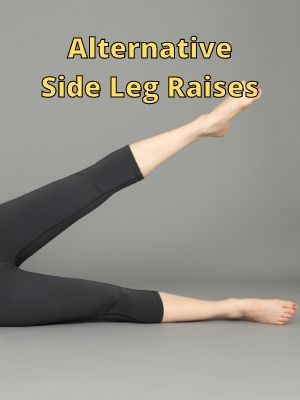
If you do a side leg raise while lying down, you can go slower and gain more control over leg movement. This type of leg raising can help you gain strength slowly without over-exerting your legs.
You may want to alternate legs every 10-20 leg raises. The point where your leg starts to feel strain is a good point note.
If you feel some strain to continue to do side leg raises, that a good indication your muscles are starting to get some effective exercise.
If you feel no strain you may want to do more repetitions or hold the leg raised a bit longer.
10. Prone Leg Raises to Strengthen Your Knees
Prone Leg Raises by Help ShoeIf you feel comfortable lying on your stomach, this might be one of the first knee strengthening exercises you want to try. Similar to other leg raises, yet your leg goes back instead of forwards or sideways.
This exercise will help strengthen your back, glutes, and hamstring muscles. Since your upper body can relax for the most part, you may be able to do this exercise with little strain on your back.
Remember to isolate your leg muscles and keep your stomach on the floor. This will help ensure you don’t strain your back if your leg starts to get difficult to lift.
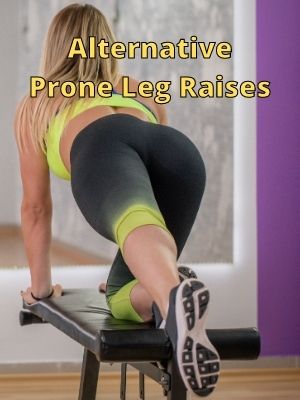
While on the floor or on a bench you can get on your hands and knees and lift your leg out straight.
You’ll be resisting gravity as you extend your leg out fully.
You can modify this exercise by raising your leg to higher or lower levels based on your abilities.
A slow and steady motion will ensure more muscle engagement through the range of motion.
You can also hold your leg up for extended periods once you are ready for more resistance.
11. Squats to Strengthen Your Knees
Squats by Help ShoeSquats are a part of our everyday life. We sit down and get up repeatedly throughout the day. Yet, we don’t do squats in a repetitive manner unless we are exercising.
This exercise will help strengthen your quadriceps, hamstring, glute, and calf muscles. These muscles can give our knees a good support system for a strong knee.
The goal is to keep your back straight and bend your knees until your legs are at about 90 degrees. Squatting too far down can put a strain on your knees and should be avoided if possible.
If you are squatting and feel comfortable, it likely that your legs are shoulder-width apart or more, your toes are slightly pointing out, and you’re squatting down the right amount.
Any type of repetitive motion can become a problem if done incorrectly, too much, or with too much strain.
Try to make sure you have good form and feel muscle tension and not strain from overworked muscles.

If you are ready to increase the resistance you can start using weights. Start off with the lightest pair of weights you have, just to make sure you know how your knees feel.
Then increase the weight by 5 or 10 during the next set if your knees are feeling good. Take it slow and continue to monitor your knees. You should be able to do a set of 10 squats with weights without a struggle to do all 10.
If you are struggling after your second set of 10 squats, this could be helpful for increased muscle strength as long as you maintain good form (straight back, don’t go too low, and maintain control).
Once your muscles are too tired, you may start to lose good form or you feel pain, then you need to stop.
12. Wall Squats to Strengthen Your Knees
Wall Squats by Help ShoeA wall squat can help you see how much strength your muscles have. This exercise will help strengthen your quadricep, glute, and calf muscles.
The wall squat is similar to a squat but uses the wall as support. This way you can stay in a squatted position for longer periods without knee strain.
You may want to do a wall squat for 5 – 30 seconds to start. As you hold this position, your muscles will start to strain. If you are struggling to maintain the squat you know your muscles are working hard and it’s about time to stand up.
How long you squat should be determined by finding out how long you can reasonably hold the squat with good form before your muscles get too tired. Once you find out your maximum time for a wall squat, then you should reduce the time so you can do several squats during your exercise routine and avoid excess muscle strain.
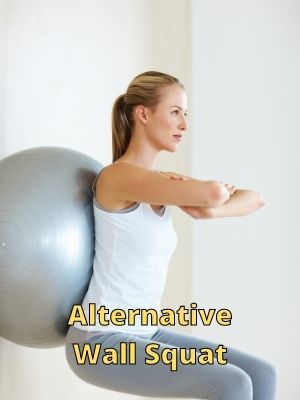
Here’s a fun alternative to a wall squat. Using an exercise ball can give you more support while you are squatting against the wall.
The ball not only gives you better support but can be used to engage more leg muscles as you stand up and squat down.
You’ll need to adjust yourself and place the right amount of pressure on the ball as you move, helping your legs engage a wider range of muscles.
Make sure your feet are far enough forward so your legs make a good 90-degree angle. It should look like you’re sitting in an invisible chair.
When you stand up you’ll notice your body is at an angle to the wall.
Free Weights, Machines, or Neither
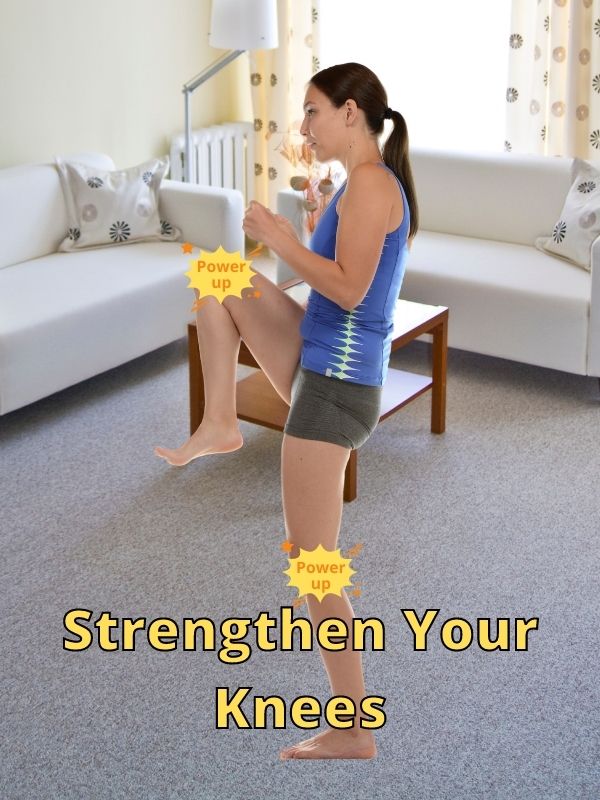
Free weights are good but may lead to a greater chance of injury if your muscles are weak. The good thing about free weights is that they are usually more natural to use. They allow you to position your body in natural biomechanical positions that our body is used to.
If you use light weights and increase slowly over time, then free weights are probably going to be of more benefit for strengthening your knees.
Free weights are good for those who have weak knees and can lift at least a little weight with proper form.
Exercise machines are good for a more controlled exercise. If used correctly, they can reduce the chance of injury by supporting your body in a stationary position while you isolate the muscles you want to work on.
The problem with machines is that some of them don’t allow a full range of natural biomechanical motion. They sometimes restrict movements and place bodies in some awkward positions.
Machines are good for those recovering from injuries, who need support and minimal weight placed on certain areas.
A weightless workout is a great option for anyone because it can be modified to your specific needs. You can do a workout from home and you don’t need much to get great results. Sometimes all you need is a chair to get a full workout.
You can work a wide range of muscles, including muscles that strengthen the knees, when you do a no weights or no equipment workout.
Weightless workouts are good for most everyone if they use caution not to push their bodies too far.
Final Thoughts
Strengthening your knees can help you recover from injury, reduce pain, and help you prevent future injuries. The exercises mentioned in this article can aid in strengthening your knees if done properly and with caution regarding knowing your limits.
If you have a goal to strengthen your knees, getting into a healthy exercise routine can be very beneficial. Get the advice of your doctor before beginning and make sure you plan out your exercise routine for a successful outcome.
Thanks for visiting Helpshoe.com

